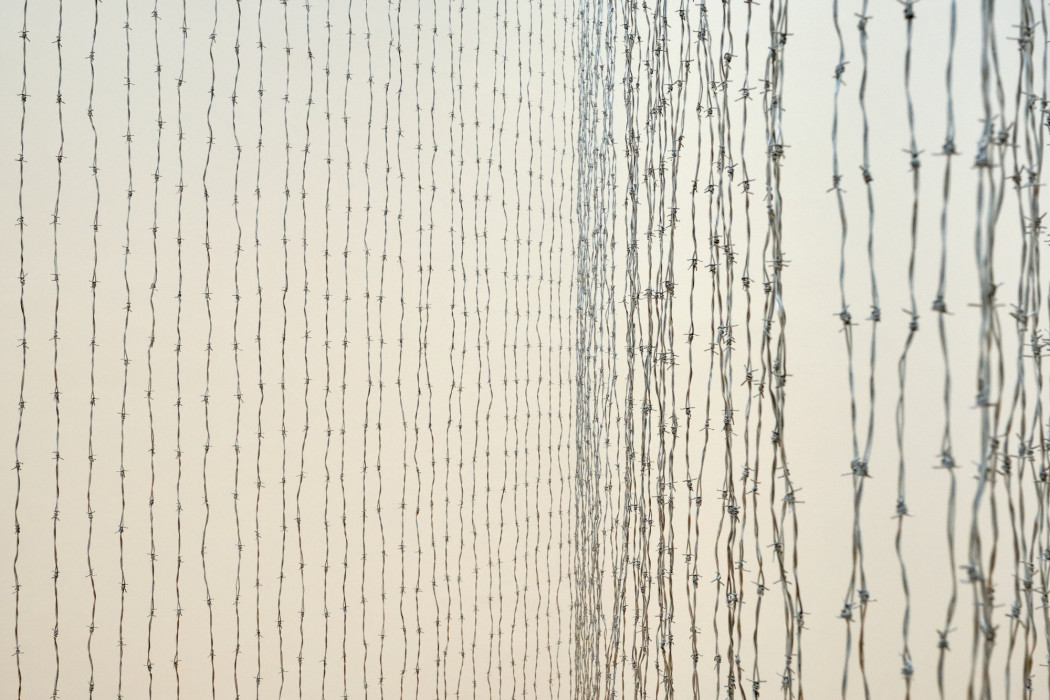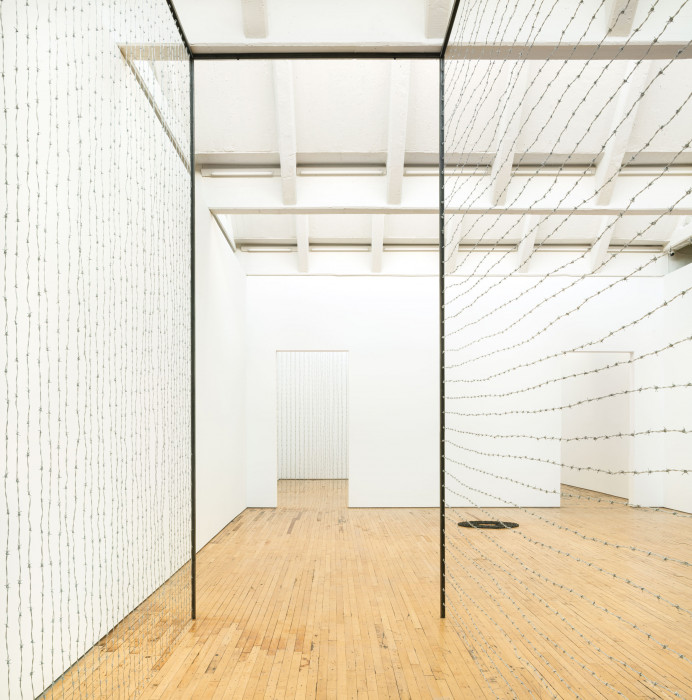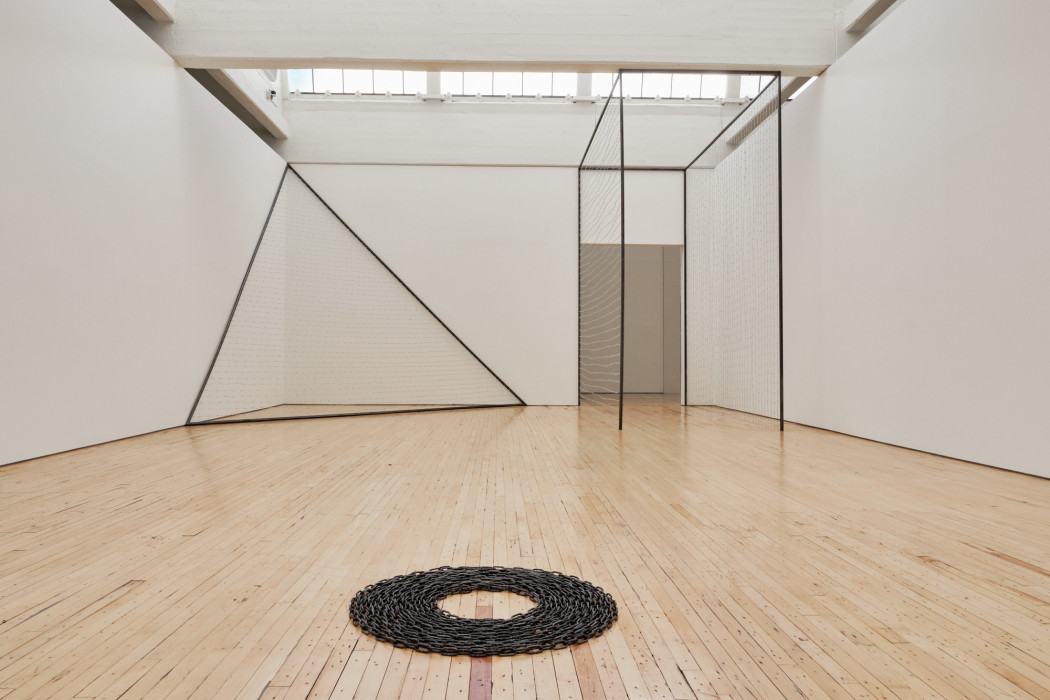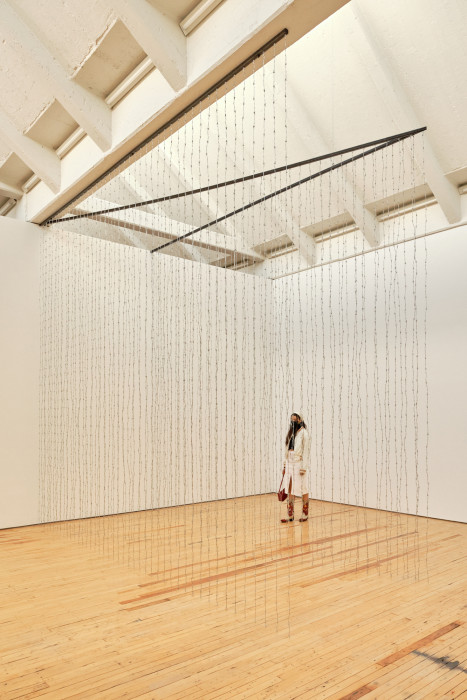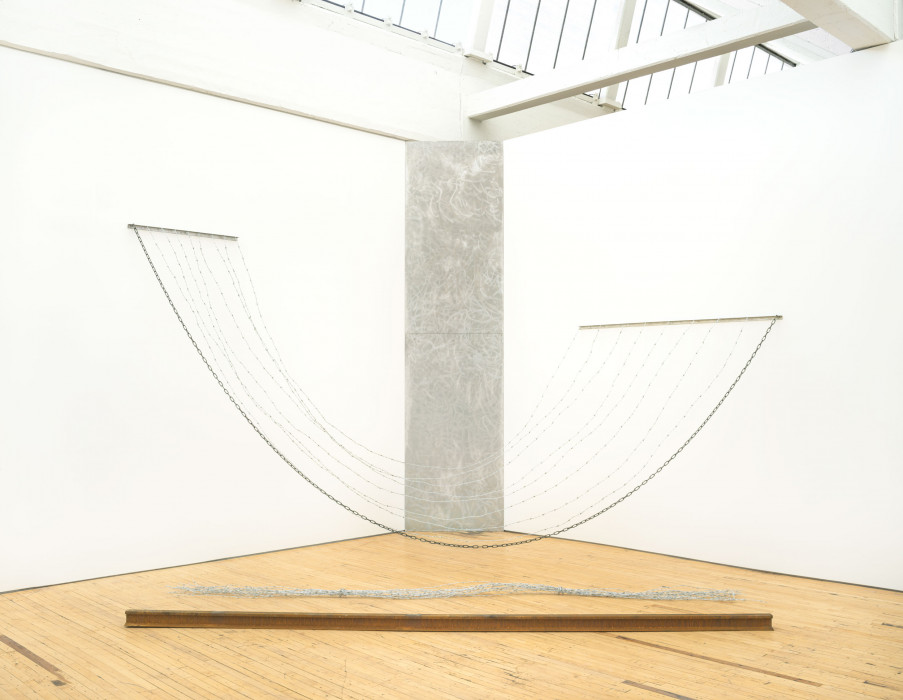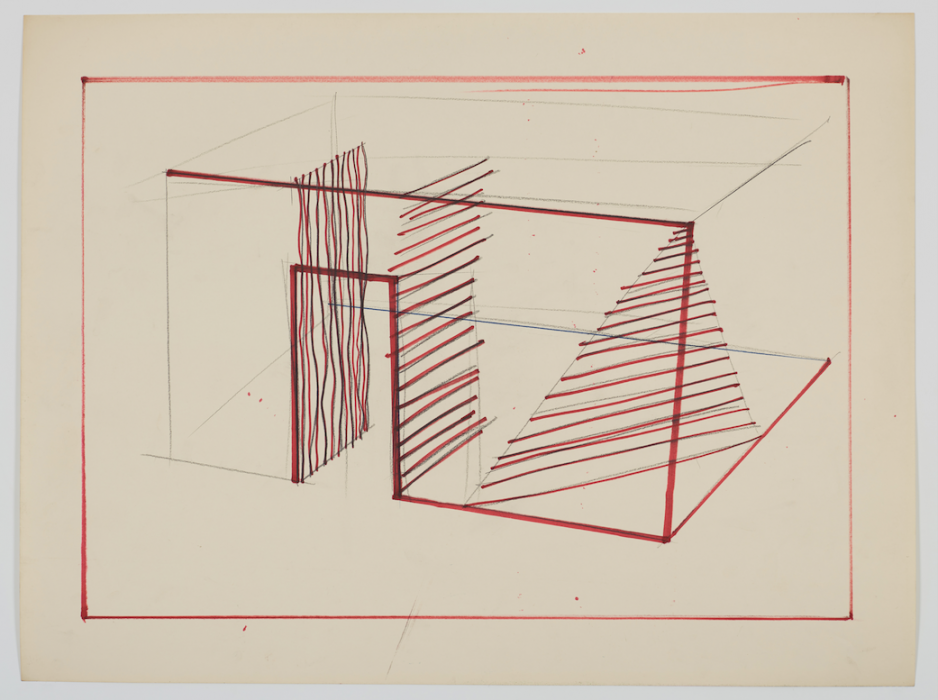Melvin Edwards
Long-term view, Dia Beacon
Overview
This exhibition presents a group of previously unrealized installations from one of sculptor Melvin Edwards’ most dynamic bodies of work. In a brief but prolific period between 1969 and 1970, Edwards developed a series of environmentally scaled sculptures using steel from barbed wire. Each work consists of a simple geometric construction that volumetrically subdivides a space. The punctuated lines of this material are pulled across a section of a room, using linearity to create depth and dimension and heightening what the artist describes as the “painfully dynamic and aggressive resistance” of the material. In dialogue with the contemporaneously emerging field of Postminimal art, Edwards’s barbed wire sculptures explore geometry in suspension. Meanwhile, the material’s evocative referentiality—to a social, agricultural, and militaristic history of containment and bondage—ensures these works resist resolution. Four of these installations, three of which recently entered Dia’s permanent collection, are on view here for the first time. Together, they interrupt the architectural frame of Dia Beacon, provocatively delineating passageways and obstructing corners.
Melvin Edwards is organized by Alexis Lowry, curator, Dia Art Foundation, with Zuna Maza, curatorial assistant.
Melvin Edwards is made possible by Peter Marino, the David Schwartz Foundation, Inc., and an anonymous donor.
Between 1969 and 1970, Melvin Edwards developed a series of sculptures using barbed wire—or “b.wire,” to use the artist’s term—that embrace the material’s formal and evocative potential. Edwards suspends these simple geometric constructions, which at times feature chains, across a section of a room. By subdividing space in this way, these works operate at an architectural scale. Though he had been using chains since the early 1960s, he turned to b.wire as a material for sculpture while living at a farmhouse and teaching at Orange County Community College in the Hudson Valley. Reencountering the material after a childhood spent around farms in Texas, the artist saw the opportunity to use it to draw dynamically in the gallery space.
The first b.wire works were presented as site-responsive installations in 1969. In March 1970 Edwards mounted four of these sculptures for a solo exhibition at the Whitney Museum of American Art, New York—the institution’s first single-artist show by an African American sculptor. He went on to use b.wire in a variety of other sculptures and works on paper, even collaborating with his late wife, poet Jayne Cortez, to create lined paper using impressions of the metal. He has since returned to the architectural approach of these first installations only a handful of times. Conceived as drawings in 1970, the works on view at Dia Beacon have been fabricated for the first time and are installed in response to Dia’s galleries.
The works demarcate or obstruct passageways, corners, and sections of rooms. Formally in dialogue with Fred Sandback’s planar cuts into space using yarn (also on view at Dia Beacon), Edwards’s b.wire sculptures use the material’s inherent linearity to create depth without obscuring space. In other works such as Iguneronmwon (1970/2022), the artist strategically lets the wires and chain sag with gravity, a gesture in conversation with his contemporary Sam Gilliam, whose Drape paintings (one of which is in Dia’s collection) consist of folded and hung canvas. Iguneronmwon also points to Edwards’s later use of b.wire as one component among many in more object-like sculptures.
The artist is best known for welded sculptures such as those in his Lynch Fragment series (1964– ), which combine chains, horseshoes, nails, locks, and hammerheads, among other metallic materials, into densely packed wall reliefs. The abstract visual language created by these “familiar form objects”—as the artist calls them—at times embed contradictory layers of meaning within each work. These formal gestures, as well as his early experiments with suspension, anticipate his later b.wire works, which he began in earnest while living in New York. Moving there from Los Angeles in 1967, Edwards joined the Smokehouse Associates, an artist collective based in Harlem. The group created abstract murals on the sides of buildings and installed Edwards’s sculptures in adjacent lots, positing abstraction as a catalyst for social transformation. The artist took on several public sculpture commissions during this time, and his work began to grow in scale.
As in Edwards’s earlier work, the straightforward geometry of the b.wire sculptures is complicated by the material’s agricultural, colonial, and militaristic associations. Acknowledging their “brutalist connotations,” the artist explained in 1970 that his “creative thoughts have always anticipated the beauty of utilizing that necessary complexity . . . in what could be straight ahead formal works.” In this series, he continues, “Linear geometry [has] its purity complicated because one chooses to exploit the flexibility of the wire. A geometric organization [appears] to be something else now you see it now you don’t.”
—Zuna Maza

This gallery contains barbed wire. Children must be accompanied by an adult.
- We Know the Way, 1970/2022
Galvanized steel and steel
Dia Art Foundation
- Gonogo, 1970/2022
Galvanized steel and steel
Dia Art Foundation
- Equal Memories, 1970/2022
Galvanized steel
Dia Art Foundation
- Iguneronmwon, 1970/2022
Galvanized steel, stainless steel, and steel
Courtesy the artist and Alexander Gray Associates, New York
Melvin Edwards was born in Houston in 1937. He moved to Los Angeles in 1955, where he attended the University of Southern California, and then on to New York in 1967. For over fifty years, he has used suggestive materials and poetic titles to bring out the sociopolitical possibilities of formal sculptures. After learning to weld in 1960, he began assembling knives, chains, and other recognizable metal objects into the modestly sized, abstract sculptural reliefs that would come to be known as the Lynch Fragments series (1964– ). The artist has steadily worked with paper, making impressions on its surface with metal and pigments. The barbed wire works, a selection of which were recently acquired by Dia Art Foundation, were first shown in group shows at the Studio Museum in Harlem, New York, and at Art Gallery, State University of New York at Stony Brook (both 1969), and in his solo presentation at the Whitney Museum of American Art, New York (1970). His work has been the subject of retrospectives at the Nasher Sculpture Center, Dallas (1993), and the Neuberger Museum of Art, Purchase, New York (2015). He has also realized many public art commissions. From 1972 to 2002, Edwards taught at Rutgers University in Newark, New Jersey. In 2014 he received an honorary doctorate from the Massachusetts College of Art and Design, Boston.
Artist
Melvin Edwards
(1937)
Melvin Edwards was born in Houston, Texas, in 1937. He lives and works in New York.
Selected Works on View
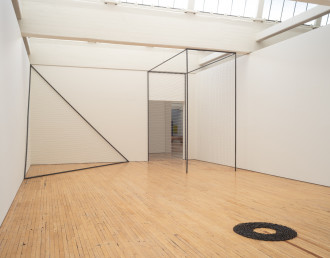
Melvin Edwards
We Know the Way, 1970/2022
Go to We Know the Way page.jpg)
Melvin Edwards
Equal Memories, 1970/2022
Go to Equal Memories page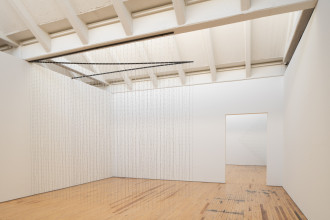
Melvin Edwards
Gonogo, 1970/2022
Go to Gonogo pageBooks
Melvin Edwards: Five Decades
